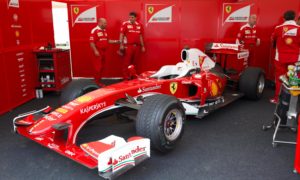Martin Whitmarsh looks to have sparked yet another technical controversy in F1, after suggesting that Red Bull’s pace is being aided by an illegal ride-height control system.
Given the ban on refuelling and the continuation of the parc ferme conditions, teams have been forced to run their cars further from the ground to compensate for the extra fuel weight which drivers are forced to carry at the start of each Grand Prix. This has, in theory, limited the performance of each car in qualifying, which takes place in low-fuel conditions.
However, Whitmarsh believes that Red Bull has been able to get around this problem by using a system to automatically adjust the ride height of its cars. Such a claim can be supported by on board camera images of Mark Webber’s Red Bull, which appear to show the Australian’s car occasionally bottoming-out during qualifying.
“There’s evidence there are ride-height control systems which many people thought weren’t permissible,” the McLaren team principal told the BBC.
“It looks like Red Bull and some other cars are able to run lower in qualifying than you would expect if they’re then going to fill the car with fuel afterwards,” Whitmarsh said.
“As you can imagine, we’re working quite hard on those systems now.
“The original rulings suggested such systems wouldn’t be allowed on cars but we’re seeing some cars which seem to have them.
“We’ve got to have them fitted as soon as we can – hopefully by China we’ll have something on the car.”
Whitmarsh’s accusations have been strongly rejected by his counterpart Christian Horner, who stated that he could “absolutely guarantee” that his cars did not run such a system.
Mercedes GP’s Ross Brawn has also voiced his concerns about the proposed system, stating that the FIA should issue a rules clarification regarding the issue.
Controversy surrounding the issue of ride-heights is not new to Formula One
In 1981, the constructor teams introduced ride-height adjustors in a bid to defy the governing body’s new minimum ground clearance rule and its ban on sliding-skirts. The first of these was introduced by Bernie Ecclestone’s Brabham team, with Gordon Murray devising a sophistocated Hydropneumatic suspension system for the BT49C which used compressed air to act as a spring, while the car was in motion, and therefore push it towards the ground. Ultimately, this meant that the car’s ride-height was legal while stationary in the pits, but dropped once out on track.








